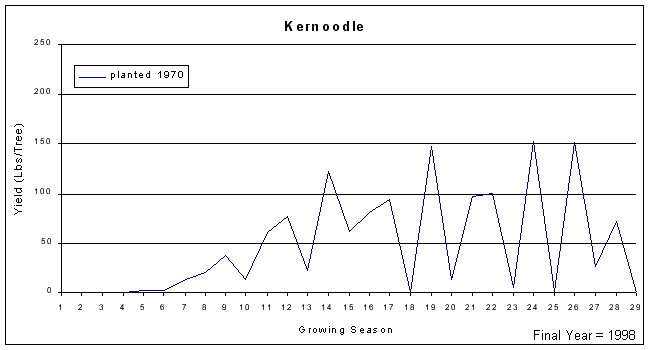Kernodle

Average nut quality of test trees.
| # Nuts / lb. | % Kernel | Kernel quality breakdown | Specific gravity | ||
| % Fancy | % Standard | % Amber | |||
| 44 | 53% | 19% | 27% | 6% | .69 |
History
Introduced in 1957 by J.A. Kernodle of Camp Hill, AL. It is a seedling selection (Thompson and Young, 1985).
Comments
*Note: This is an older cultivar planted in the Young Variety Test at the Tifton Campus. Trees were planted decades ago when care was very different than it is now, and trees received much less care, so production data will reflect this fact. Trees began receiving insecticides in 1962, fungicides in 1970, nitrogen in 1962, and drip irrigation in 1975. The data for this cultivar was collected by several individuals, but the bulk of the data and the comments are from my predecessor Dr. Ray Worley. This information was originally published here: Worley and Mullinix, 1997.
An extra-large nut (45 nuts/lb) with high percent kernel (53). Kernels are smooth and attractive but a little dark. Nuts frequently split at the suture at harvest, but kernels are usually still good. This cultivar seems to often be mixed in by mistake in nursery trees. I have seen several orchards that have a few 'Kernoodle' trees mixed in them. One of the best of the "Super Big" pecans. Not suitable for commercial production, but a fun yard tree with the large size and thin shell.
Production record of test trees beginning in year planted
'Kernodle' production from the Young Variety Test. Each colored line represents the yearly production in pounds of nuts from an individual tree beginning the year planted.
Alternate Bearing Intensity* = (not enough data)
*Computed from mature trees using data from years after trees began receiving fertilizer and pesticide sprays.

